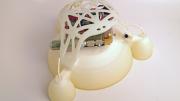For most people, the word “robot” conjures up the image of a lumbering metallic machine. Now, researchers report that they can fabricate robots with the exact opposite features—soft, pliant, and mobile—using 3-D printing.
Today in Science, researchers at the Paulson School of Engineering and Applied Sciences and the Wyss Institute for Biologically Inspired Engineering announce a new technique to manufacture soft-bodied robots with far greater mobility than previous iterations.
Compared to their traditional counterparts, soft robots are better adapted to unstructured environments, more capable of squeezing into tight spaces, and safer for use in interactions with humans. They do have some rigid parts, such as batteries and pumps, because current technology is not yet capable of manufacturing such components from soft materials, notes Robert Wood, Charles River professor of engineering and applied sciences, the paper’s senior author, who is best known for creating a microrobotic fly.
The key challenge in manufacturing soft robots is to effect a gradual, rather than abrupt, transition between the robot’s soft and rigid parts, because an abrupt interface can result in mechanical failure. The researchers were able to engineer this gradual transition in a newly designed robot that weighs less than two pounds, using materials whose rigidity ranges from the softness of human skin to the hardness of plastics. Its motions are powered by the combustion of butane and oxygen inside its body; this allows for dramatic movements, such as jumping two and a half feet high (six times its body height).
The robot was manufactured by a state-of-the-art multimaterial 3-D printer housed at Harvard’s microrobotics laboratory. According to lead author Nicholas Bartlett, a graduate student, this effort represents one of the first attempts to manufacture full-scale robots using 3-D printing, a technology often used to fabricate components and molds, but rarely entire robots. Printing just one of these hybrid robots takes about 15 hours, but using 3-D printing makes the numerous design iterations—often necessary in robotics—much less complicated. “We can make a simple change in the software, and press print,” said Wood. “The next morning it will be ready.”
The new soft robot could prove useful in the exploration of hazardous environments, as in the aftermath of a disaster, Bartlett said. The jumping motion allows the robot to hurdle barriers such as fallen trees and rocks, and its flexible lower surface enables the navigation of uneven surfaces, which often present difficulties for traditional robots. Another potential use is in space exploration: soft robots would have little trouble with the rough terrain and debris on the surfaces of the moon and Mars, according to Bartlett, while the lower gravity on these planets makes its jumping motion more efficient.
When designing soft robots, Bartlett explained, scientists often look to nature for inspiration. For example, the gradual soft-hard transition featured in the new robot is also found in octopuses, which have soft bodies and rigid beaks. “Biology’s done a good job of making some amazing structures,” he said. “So why not mirror them?”









